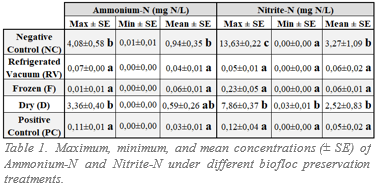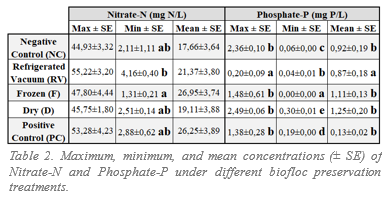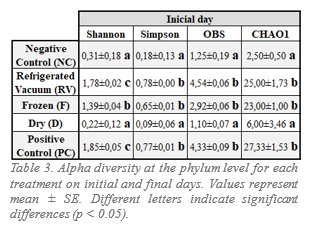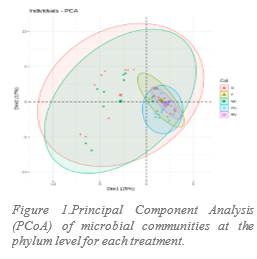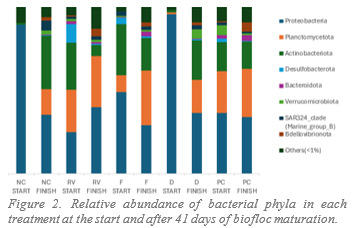EFFECT OF BIOFLOC CONSERVATION ON BACTERIAL POPULATIONS AND EVALUATION OF THEIR EVOLUTION FOLLOWING BIOFLOC REINOCULATION
Introduction: Biofloc technology (BFT) is a proven production system that enables the cultivation of aquatic animals at high densities while maintaining water quality through the activity of various organisms, mainly bacteria. These bacteria perform multiple key functions, including nutrient transformation, nitrogen compound removal, floc formation, and organic matter exchange. Starting a biofloc system requires time and can lead to ammonium and nitrite peaks in the water, but reinoculation with mature biofloc can accelerate the process, provided that an established system is available. Otherwise, preserving biofloc may offer a solution to reduce maturation time, as long as its microbial and functional diversity is maintained during storage.
Materials and methods: Mature biofloc was collected, decanted and filtered to reduce moisture content. Afterwards, samples were subjected to three preservation treatments: refrigerated vacuum (RV), frozen (F), and dry (D). RV samples were stored in vacuum-sealed bags at 4°C. F samples were mixed with 15% glycerol and stored at -80°C. D samples were dried at 40°C. A negative control (NC) was not inoculated, while a positive control (PC) was directly inoculated with fresh, decanted, and pressed biofloc. All inoculated groups received biofloc at a concentration of 1 g/L. These preservation techniques are patented (P202530281). The storage period before inoculation was 7 days. Each treatment had three replicates (80 L tanks, aerated, at 28°C). Penaeus vannamei (76 g/tank) were stocked. Water samples were collected weekly to analyze nitrogen compounds (ammonium, nitrite, nitrate) and phosphorus (phosphate) concentrations. Microbial diversity was analyzed on days 0, 6, 21, and 41.
The full-length 16S rRNA gene was amplified using barcoded primers 27F and 1492R. PCR (27 cycles) was followed by quality control and equimolar pooling. Libraries were prepared with the SMRTbell Express Template Prep Kit 2.0 and sequenced on a PacBio Sequel II. Sequences were processed with QIIME2 using DADA2 for denoising. Taxonomy was assigned with the SILVA 138 database. Alpha diversity (Shannon, Simpson, Chao1) and beta diversity (Bray-Curtis, PCoA) were calculated. Differential abundance was analyzed with ALDEx2; Krona plots visualized taxonomic profiles.
Results and discussion: After 41 days, no Ammonium-N and Nitrite-N peaks were observed in RV, F, and PC, indicating effective nitrogen removal (Table 1). Nitrate-N levels did not differ between PC and preserved bioflocs (RV, F, D), suggesting reinoculation did not increase nitrate accumulation (Table 2). Phosphate-P was significantly lower in RV than in other treatments, likely due to microbial assimilation, as no water exchanges were made and only dissolved phosphate was measured (Table 2). These results suggest that refrigeration and freezing preserve microbial activity related to nitrogen and phosphorus cycling.
At day 0, alpha diversity at the phylum level (Shannon, Simpson, Chao1, OBS) was significantly lower in NC and D, indicating reduced microbial richness compared to RV, F, and PC. RV and PC were similar, showing that refrigeration effectively preserved phylum-level diversity, while F showed a moderate reduction. After 41 days, all diversity indices converged across treatments, suggesting that biofloc maturation stabilized microbial communities at the phylum level.
Beta diversity at the phylum level, visualized by PCA (Figure 1), showed that RV and PC communities clustered closely, indicating similar microbial structures. F samples were moderately similar, while NC and D formed separate and more dispersed clusters, reflecting higher variability due to lack of inoculation or drying. RV, F, and PC showed lower dispersion, likely due to better preservation of the initial community.
Respect to taxonomy compositions, Proteobacteria and Planctomycetota were the most dominant phyla across all treatments (Figure 2). Significant differences were observed between the initial communities of NC and RV, particularly in these two phyla, suggesting that refrigeration preserved a more functional microbial structure. In contrast, no significant differences were found between the initial profiles of RV and PC, indicating effective preservation of the original biofloc community in RV. For F treatment, similar patterns were observed; however, significant differences emerged between the initial F and PC communities, suggesting a partial alteration due to freezing. Notably, nitrifying bacteria, which are crucial for nitrogen cycling, belong to the Proteobacteria phylum, highlighting the importance of maintaining this group during biofloc preservation.
References: Deng, M., Zhang, W., Wang, Y., Hu, Z., & Fan, L. (2018). The effect of different carbon sources on water quality, microbial community and structure of biofloc systems. Aquaculture, 482, 103–110. https://doi.org/10.1016/j.aquaculture.2017.09.030 Acknowledgments: The study was funded by the Research Project: “Optimizing shrimp feeding and nutrition in biofloc system (BioFlango)” (PID2020-114574RB-C21). S. Ferrando-Juan contract by MICIN Research Personnel Training Grant (PRE2021-098367). J. Gómez-Aguilera contract was supported by European Union Next Generation-Plan of Conselleria d’innovació, Universitats, Ciència i Societat Digital of Generalitat Valenciana (INVEST/2022/434).
